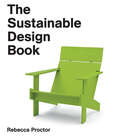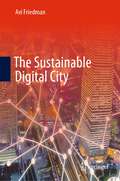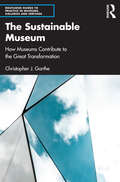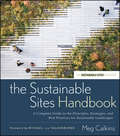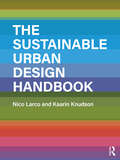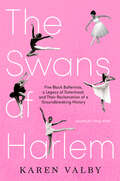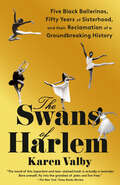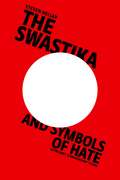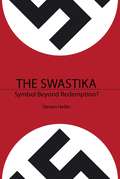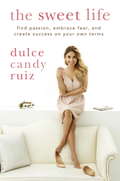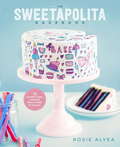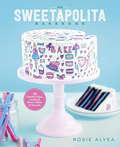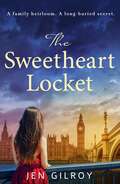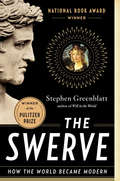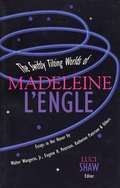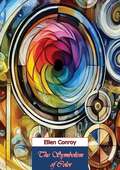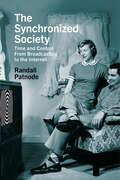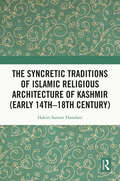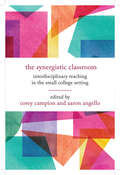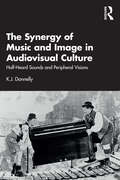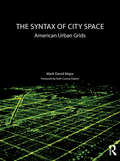- Table View
- List View
The Sustainable Design Book
by Rebecca ProctorThe Sustainable Design Book updates the reader on the latest products and developments in the field of green design, and features 265 of the most exciting new products around. Q&As with leading designers give insight into trends and key techniques used within the industry, while handy icons highlight each product's sustainability credentials at a glance. Beginning with a chapter on sustainable materials, the book goes on to cover furniture, lighting, home accessories, and personal accessories. Web addresses of designers and retailers make each product easy to source.The Sustainable Design Book is an unbeatable resource for those aspiring to best practice within the field of sustainable design, as well as students of contemporary product design. Consumers looking for beautiful but environmentally conscious products and accessories will also find this an essential guide.
The Sustainable Digital City
by Avi FriedmanThis book explores the rise of technology-centered urban planning and the diffusion of these practices around the world. Seven axes of urban planning have been selected to highlight how data and technology currently work and how these systems can be improved going forward. Each aspect is explored in its own chapter that combines narrative description, illustrations, and case studies to show how technology currently shapes our cities and how this may impact the urban environments. Topics include infrastructure, mobility, energy use and distribution, work, public health, and knowledge transfer among others. The book also demonstrates how these aspects are tied to and affect the four pillars of sustainability: environment, society, economy, and culture.
The Sustainable Museum: How Museums Contribute to the Great Transformation (Routledge Guides to Practice in Museums, Galleries and Heritage)
by Christopher J. GartheThe Sustainable Museum is the first book to outline a coherent strategy for the direction of museums, as it relates to sustainability in the museum and heritage sector. Arguing that museums must place sustainability at the centre of all their activities, if they are to become key actors with a clear societal role, Garthe considers the issues that museums will likely face as they take on their new roles. Presenting case studies from a wide range of museums around the world, the book considers different ways of implementing sustainability in different types and sizes of institutions. Whilst the book clearly outlines the need for change, it also provides guidance about how to change. Garthe does this by considering specific concepts and approaches to sustainability in relation to the different aspects of museum operations. The book includes a hands-on manual for implementing sustainability management in a museum, whilst also considering the challenges practitioners will encounter and considering what the future of the sustainable museum might look like. The Sustainable Museum will be essential reading for museum and heritage professionals around the globe. The book will also be of interest to academics and students engaged in the study of museums, arts and cultural management, business administration, change management or sustainable development.
The Sustainable Sites Handbook
by Meg CalkinsGet the definitive resource guide for sustainable site design, construction, and management. The Sustainable Sites Initiative (SITES) is transforming land design, development, and management practices across the United States with the first national rating system for sustainable landscapes. The Sustainable Sites Handbook features comprehensive and detailed information on principles, strategies, technologies, tools, and best practices for sustainable site design. Contributors to this book are some of the same experts that carefully shaped the SITES rating tool, ensuring thorough coverage of the broad range of topics related to sustainable site design. The Sustainable Sites Handbook offers in-depth coverage of design, construction, and management for systems of hydrology, vegetation, soils, materials, and human health and well-being. Focusing primarily on environmental site design and ecosystem services, this wide-ranging guide also covers issues of social equity, economic feasibility, and stewardship, which are crucial to the success of any sustainable site. Equally useful as a handbook for obtaining SITES credits or for the independent development of sustainable sites, The Sustainable Sites Handbook is an indispensible resource for practicing professionals in landscape architecture, landscape design, architecture, civil engineering, land planning, horticulture, ecology, environmental engineering, landscape contracting, and parks and recreation management.
The Sustainable Urban Design Handbook
by Nico Larco Kaarin KnudsonThe Sustainable Urban Design Handbook gathers the best sustainability practices and latest research from the fields of architecture, landscape architecture, planning, development, ecology, and environmental engineering and presents them in a graphically rich and accessible format that can help guide urban design decisions in cities of all sizes.The book presents a comprehensive framework that organizes more than 50 elements of sustainable urban design under five main topics–Energy Use & Greenhouse Gas, Water, Ecology & Habitat, Energy Use & Production, and Equity & Health–and relative to four project scales: Region & City, District & Neighborhood, Block & Street, and Project & Parcel. Each element chapter includes a summary of importance and background, compares typical practices and recommended approaches, explains connections to other elements, and concludes with urban design guidelines that can be used to directly inform projects and decisions.Easy to use and reference, The Sustainable Urban Design Handbook provides both an in-depth introduction to topics across sustainable urban design and serves as an on-going reference for anyone involved in the creation of sustainable urban environments. This resource will be useful to design and planning professionals, community members, students, and elected officials in guiding decisions about our sustainable future.
The Sustainable Urban Development Reader (Routledge Urban Reader Series)
by Stephen M. WheelerThis thoroughly revised and updated fourth edition of The Sustainable Urban Development Reader combines classic and contemporary readings to provide a broad introduction to the topic that is accessible to general and undergraduate audiences. The Reader begins by tracing the roots of the sustainable development concept in the nineteenth and twentieth centuries through classic readings. It then explores dimensions of urban sustainability, including land use and urban design, transportation, ecological planning and restoration, energy and materials use, economic development, social and environmental justice, and green architecture and building. Additional sections cover tools for sustainable development, sustainable development internationally, visions of sustainable community, and case studies from around the world. The Sustainable Urban Development Reader remains unique in presenting a broad array of sustainable city readings, each with a concise introduction placing it within the context of this evolving discourse. Presenting an authoritative overview of the field using original sources in a highly readable format, this book is a valuable resource for general readers as well as students and researchers in urban studies, environmental studies, the social sciences, and related fields.
The Swans of Harlem (Adapted for Young Adults): Five Black Ballerinas, a Legacy of Sisterhood, and Their Reclamation of a Groundbreaking History
by Karen ValbyA full accounting of five incredibly talented Black ballerinas from The Dance Theater of Harlem, founding members among them, that illuminates their hard-fought, historic, and overlooked contributions to the world of classical dance at a time when racism shut out Black dancers from major dance companies.At the peak of the civil rights movement, Lydia Abarca was the first ballerina in a Black ballet company to grace the cover of Dance magazine. Alongside founding members Shelia Rohan and Gayle McKinney-Griffith and first-generation dancers Karlya Shelton and Marcia Sells, Abarca invited a bright light to shine on Black professional classical dancers. Grit, determination, and exquisite artistry propelled these swans of Harlem to dizzying heights as they performed around the world for audiences that included celebrities, dignitaries, and royalty.Now, decades later, these trailblazing ballerinas and longtime friends are giving voice to their stories on- and offstage, reclaiming their past so that it is finally recorded, acknowledged, and lauded, never to be lost again.* "This powerful account is part cultural history, part biography as it traces the formation, rise, and decline of DTH through the experiences of these five ballerinas, as well as their continued importance to dancers of color today....this will appeal equally to fans of forgotten histories." —Booklist, starred review"A poignant and gripping piece of little-known history." —Kirkus Reviews
The Swans of Harlem: Five Black Ballerinas, Fifty Years of Sisterhood, and Their Reclamation of a Groundbreaking History
by Karen ValbyTHE NEW YORK TIMES BOOK REVIEW NOTABLE BOOK • The forgotten story of a pioneering group of five Black ballerinas and their fifty-year sisterhood, a legacy erased from history—until now.&“This is the kind of history I wish I learned as a child dreaming of the stage!&” —Misty Copeland, author of Black Ballerinas: My Journey to Our Legacy &“Utterly absorbing, flawlessly-researched…Vibrant, propulsive, and inspiring, The Swans of Harlem is a richly drawn portrait of five courageous women whose contributions have been silenced for too long!&” —Tia Williams, author of A Love Song for Ricki WildeAt the height of the Civil Rights movement, Lydia Abarca was a Black prima ballerina with a major international dance company—the Dance Theatre of Harlem, a troupe of women and men who became each other&’s chosen family. She was the first Black company ballerina on the cover of Dance magazine, an Essence cover star; she was cast in The Wiz and in a Bob Fosse production on Broadway. She performed in some of ballet&’s most iconic works with other trailblazing ballerinas, including the young women who became her closest friends—founding Dance Theatre of Harlem members Gayle McKinney-Griffith and Sheila Rohan, as well as first-generation dancers Karlya Shelton and Marcia Sells.These Swans of Harlem performed for the Queen of England, Mick Jagger, and Stevie Wonder, on the same bill as Josephine Baker, at the White House, and beyond. But decades later there was almost no record of their groundbreaking history to be found. Out of a sisterhood that had grown even deeper with the years, these Swans joined forces again—to share their story with the world.Captivating, rich in vivid detail and character, and steeped in the glamour and grit of professional ballet, The Swans of Harlem is a riveting account of five extraordinarily accomplished women, a celebration of both their historic careers and the sustaining, grounding power of female friendship, and a window into the robust history of Black ballet, hidden for too long.
The Swastika and Symbols of Hate: Extremist Iconography Today
by Steven Heller“Force[s] even the most sophisticated to rethink and rework their ideas of how images work in the world.” —School Library Journal This is a classic story, masterfully told, in a new, revised and expanded edition about how one graphic symbol can endure and influence life—for good and evil—for generations and never, even today, be redeemed. A nuanced examination of the most powerful symbol ever created, The Swastika and Symbols of Hate explores the rise and fall of the symbol, its mysteries, co-option, and misunderstandings. Readers will be fascinated by the twists and turns of the swastika’s fortunes, from its pre-Nazi spiritual-religious and benign commercial uses, to the Nazi appropriation and criminalization of the form, to its contemporary applications as both a racist, hate-filled logo and ignorantly hip identity. Once the mark of good fortune, during the twentieth century it was hijacked and perverted, twisted into the graphic embodiment of intolerance. If you want to know what the logo for hate looks like, go no further. The Nazi swastika is a visual obscenity and provokes deep emotions on all sides. The Nazis weaponized this design, first as a party emblem, then as a sign of national pride and, ultimately, as the trademark of Adolf Hitler’s unremitting malevolence in the name of national superiority. A skilled propagandist, Hitler and his accomplices understood how to stoke fear through mass media and through emblems, banners, and uniforms. Many contemporary hate marks are rooted in Nazi iconography both as serious homage and sarcastic digital bots and trolls. Given the increasing tolerance for supremacist intolerance tacitly and overtly shown by politicians the world over, this revised (and reconfigured) edition includes additional material on old and new hate logos as it examines graphic design’s role in far-right extremist ideology today.
The Swastika: Symbol Beyond Redemption?
by Steven HellerTraces the history of the swastika, from religious symbol to reviled symbol * More than 175 illustrations * Powerful examination of the impact of one graphic symbol on society. This acclaimed examination of the most powerful symbol ever created is now available in paperback. The rise and fall of the swastika, and its mysteries and misunderstandings, are fully explained and explored. Readers will be captivated by the twists and turns of the symbol's fortunes, from its pre-Nazi religious and commercial uses, to the Nazi appropriation and misuse of the form, to its contemporary applications as both a racist and an apolitical logo. In a new afterword, author Steven Heller discusses the controversy around ideas to ban the symbol and public reaction to the book since it was first published. This is a classic story, masterfully told, about how one graphic symbol can endure and influence culture for generations.
The Sweet Breath of Life: A Poetic Narrative of the African-American Family
by Ntozake Shange Kamoinge WorkshopWords and images come together in a collaboration between celebrated poet Ntozake Shange and an acclaimed group of photographers, to result in this stunning celebration of contemporary Black life in America.From the first publication of The Sweet Flypaper of Life by Langston Hughes and Roy DeCarava in 1967, to Crowns: Portraits of Black Women in Church Hats, collaborations between writers and photographers have been important in African American culture. These books examine the issues of identity and representation that have been so central to this group's efforts to thrive. The Kamoinge Workshop photographers who contributed their work to this inspiring collection consist of names that have appeared in The New York Times, National Geographic, the Museum of Modern Art (MOMA), and more. Names such as Anthony Barboza, Adger W. Cowans, Ming Smith Murray, Beuford Smith, John Pinderhuges, and many others. The Workshop&’s mission was a response from the bias portrayals of African Americans in the media. They sought to shed positive light on their subjects, as well as to demystify Black life in America. And The Sweet Breath of Life does exactly that.
The Sweet Life
by Dulce Candy RuizThe YouTube star and beauty guru shares her hard-won lessons on success, style, and finding the sweetness in all aspects of your life. Since posting her first makeup tutorial in 2008, Dulce Candy has become one of the top beauty stars on YouTube, boasting more than 2 million subscribers and garnering hundreds of millions of views of her bright and energetic videos. But before she became a style icon and a role model to millions of young women, Dulce struggled to make her way in the world. Having emigrated with her family from Mexico to the United States when she was six years old, Dulce battled depression and low self-esteem as a teenager and eventually enlisted in the army in an attempt to turn her life around. It was here, on the battlefields of Iraq, that she finally uncovered and embraced her true passion--fashion and beauty--and gained the confidence to move on from her past, follow her dream, and launch what would become her wildly successful brand. The Sweet Life chronicles Dulce Candy's inspiring story, showing that anyone can be successful no matter their background and sharing the hard-won lessons that helped transform her from a shy, self-doubting teenager into a confident business woman and beauty expert. According to Dulce, you can't live the sweet life until you accept who you are--flaws and all--and take chances--knowing that failure is just a part of learning and fear is a sign that you're trying something new and exciting. Drawing on anecdotes from her own life and career, Dulce offers advice on building a personal brand ("Know what makes you different"), building confidence ("Fake it till you make it") and balancing the personal and the professional ("Don't settle when you settle down"). She also emphasizes the importance of both inner and outer beauty, encouraging women to love themselves, ignore the critics, and flaunt their own original style. Part memoir, part manifesto, The Sweet Life is a fun, inspirational guide for any woman who wants to find success and happiness without compromising who she is.From the Hardcover edition.
The Sweetapolita Bakebook
by Rosie AlyeaPaint, doodle, and sprinkle your way to stunning one-of-a-kind sweets. The world of Sweetapolita is sparkly and sprinkly and charming as can be, with 75 recipes for everything from pretty homemade cookies to decadent layer cakes. But what really sets these treats apart are interactive designs that let everyone in on the fun of decorating: Painted Mini Cakes are served with edible "paint" for guests to personalize at the table, the fondant-covered tiered Chalk-a-Lot cake is paired with homemade edible "chalk," and Rainbow Doodle cookies are made for kids to go to town on with edible markers. Rosie Alyea, the creator of the Sweetapolita blog, frolics in flour and frosting, and she loves to get her two young daughters involved, too. The pages of her debut book are full of playful ideas that will inspire creativity in bakers of all levels--including a recipe for making sprinkles at home and numerous ways to showcase them, such as the Sprinkle-Me-Silly Pizza with rainbow jimmies and nonpareils galore. With 75 full-color photographs of cookies, cakes, and more plus step-by-step technique tutorials, The Sweetapolita Bakebook will change the way bakers decorate, while entertaining every kid--and kid-at-heart.
The Sweetapolita Bakebook
by Rosie AlyeaPaint, doodle, and sprinkle your way to stunning one-of-a-kind sweets. The world of Sweetapolita is sparkly and sprinkly and charming as can be, with 75 recipes for everything from pretty homemade cookies to decadent layer cakes. But what really sets these treats apart are interactive designs that let everyone in on the fun of decorating: Painted Mini Cakes are served with edible "paint" for guests to personalize at the table, the fondant-covered tiered Chalk-a-Lot cake is paired with homemade edible "chalk," and Rainbow Doodle cookies are made for kids to go to town on with edible markers. Rosie Alyea, the creator of the Sweetapolita blog, frolics in flour and frosting, and she loves to get her two young daughters involved, too. The pages of her debut book are full of playful ideas that will inspire creativity in bakers of all levels--including a recipe for making sprinkles at home and numerous ways to showcase them, such as the Sprinkle-Me-Silly Pizza with rainbow jimmies and nonpareils galore. With 75 full-color photographs of cookies, cakes, and more plus step-by-step technique tutorials, The Sweetapolita Bakebook will change the way bakers decorate, while entertaining every kid--and kid-at-heart.
The Sweetheart Locket: A gripping and emotional WW2 page turner
by Jen GilroyA story that will linger in your heart long after you finish it' Maisie ThomasWhat if the key to your present lies in the past?London, 1939On the eve of the Second World War, Canadian Maggie Wyndham defies her family and stays in England to do her bit for the war effort. Torn between two countries, two men and living a life of lies working for the Special Operations Executive (SOE), Maggie's RAF sweetheart locket is part of who she is...and who she isn't.San Francisco, 2019Over twenty years after Maggie's death, her daughter Millie and granddaughter Willow take a DNA test that's supposed to be a bit of fun but instead yields unexpected results. Willow has always treasured her grandmother's sweetheart locket, both family heirloom and a symbol of her grandparents' love story. But now she doesn't know what to believe. She embarks on a search for the truth, one she doesn't know will reveal far more about herself...A gripping and heart-breaking dual timeline novel about love, loss and buried secrets, The Sweetheart Locket is perfect for fans of Lorna Cook, Rachel Hore and Suzanne Kelman.
The Sweetheart Locket: A gripping and emotional WW2 page turner
by Jen Gilroy'A story that will linger in your heart long after you finish it' Maisie ThomasWhat if the key to your present lies in the past?London, 1939On the eve of the Second World War, Canadian Maggie Wyndham defies her family and stays in England to do her bit for the war effort. Torn between two countries, two men and living a life of lies working for the Special Operations Executive (SOE), Maggie's RAF sweetheart locket is part of who she is...and who she isn't.San Francisco, 2019Over twenty years after Maggie's death, her daughter Millie and granddaughter Willow take a DNA test that's supposed to be a bit of fun but instead yields unexpected results. Willow has always treasured her grandmother's sweetheart locket, both family heirloom and a symbol of her grandparents' love story. But now she doesn't know what to believe. She embarks on a search for the truth, one she doesn't know will reveal far more about herself...A gripping and heart-breaking dual timeline novel about love, loss and buried secrets, The Sweetheart Locket is perfect for fans of Lorna Cook, Rachel Hore and Suzanne Kelman.
The Swerve: How The World Became Modern
by Stephen GreenblattWinner of the Pulitzer Prize for Nonfiction • Winner of the National Book Award • New York Times Bestseller Renowned scholar Stephen Greenblatt brings the past to vivid life in what is at once a supreme work of scholarship, a literary page-turner, and a thrilling testament to the power of the written word. In the winter of 1417, a short, genial, cannily alert man in his late thirties plucked a very old manuscript off a dusty shelf in a remote monastery, saw with excitement what he had discovered, and ordered that it be copied. He was Poggio Bracciolini, the greatest book hunter of the Renaissance. His discovery, Lucretius’ ancient poem On the Nature of Things, had been almost entirely lost to history for more than a thousand years. It was a beautiful poem of the most dangerous ideas: that the universe functions without the aid of gods, that religious fear is damaging to human life, that pleasure and virtue are not opposites but intertwined, and that matter is made up of very small material particles in eternal motion, randomly colliding and swerving in new directions. Its return to circulation changed the course of history. The poem’s vision would shape the thought of Galileo and Freud, Darwin and Einstein, and—in the hands of Thomas Jefferson—leave its trace on the Declaration of Independence. From the gardens of the ancient philosophers to the dark chambers of monastic scriptoria during the Middle Ages to the cynical, competitive court of a corrupt and dangerous pope, Greenblatt brings Poggio’s search and discovery to life in a way that deepens our understanding of the world we live in now. “An intellectually invigorating, nonfiction version of a Dan Brown–like mystery-in-the-archives thriller.” —Boston Globe
The Swiftly Tilting Worlds of Madeleine L'Engle
by Luci ShawIn honor of Madeleine L'Engle's 80th birthday, a host of prominent writers and academics gather to create this unique collection. Madeleine's circle of friends and peers (writers, poets, scholars, theologians) here provide an intimate portrait of L'Engle and respond to her writings and mentoring influence.Ranging from the personal to the academic, these essays illuminate the many worlds of Madeleine's writings: the private, the reflective, the theological, the scientific, the mythic, and the literary.From the Trade Paperback edition.
The Switch: An Off and On History of Digital Humans
by Jason PuskarFrom the telegraph to the touchscreen, how the development of binary switching transformed everyday life and changed the shape of human agency The Switch traces the sudden rise of a technology that has transformed everyday life for billions of people: the binary switch. By chronicling the rapid growth of binary switching since the mid-nineteenth century, Jason Puskar contends that there is no human activity as common today as pushing a button or flipping a switch—the deceptively simple act of turning something on or off. More than a technical history, The Switch offers a cultural and political analysis of how reducing so much human action to binary alternatives has profoundly reshaped modern society. Analyzing this history, Puskar charts the rapid shift from analog to digital across a range of devices—keyboards, cameras, guns, light switches, computers, game controls, even the &“nuclear button&”—to understand how nineteenth-century techniques continue to influence today&’s pervasive digital technologies. In contexts that include musical performance, finger counting, machine writing, voting methods, and immersive play, Puskar shows how the switch to switching led to radically new forms of action and thought. The innovative analysis in The Switch makes clear that binary inputs have altered human agency by making choice instantaneous, effort minimal, and effects more far-reaching than ever. In the process, it concludes, switching also fosters forms of individualism that, though empowering for many, also preserve a legacy of inequality and even domination.
The Symbolism of Color
by Ellen Conroy“The Symbolism of Color by Ellen Conroy is a comprehensive guide to the meanings and significance of colors in art, literature, and culture. The book explores the symbolism of colors across different cultures and time periods, delving into the psychological, emotional, and spiritual associations that people have with different hues. The book begins with an overview of the history of color symbolism, tracing the roots of color symbolism back to ancient civilizations such as Egypt, Greece, and Rome. From there, it explores the symbolism of individual colors, including red, blue, green, yellow, purple, black, and white. Each chapter delves into the cultural and historical significance of the color, as well as its psychological and emotional associations. Throughout the book, Conroy draws on examples from art, literature, and popular culture to illustrate the ways in which color symbolism has been used throughout history. She also provides practical advice for using color symbolism in creative projects, such as painting, writing, and design. Overall, The Symbolism of Color is a fascinating exploration of the ways in which color has been used to convey meaning and emotion throughout history. It is a must-read for anyone interested in art, literature, psychology, or cultural studies.”-Print ed.
The Synchronized Society: Time and Control From Broadcasting to the Internet
by Randall PatnodeThe Synchronized Society traces the history of the synchronous broadcast experience of the twentieth century and the transition to the asynchronous media that dominate today. Broadcasting grew out of the latent desire by nineteenth-century industrialists, political thinkers, and social reformers to tame an unruly society by controlling how people used their time. The idea manifested itself in the form of the broadcast schedule, a managed flow of information and entertainment that required audiences to be in a particular place – usually the home – at a particular time and helped to create “water cooler” moments, as audiences reflected on their shared media texts. Audiences began disconnecting from the broadcast schedule at the end of the twentieth century, but promoters of social media and television services still kept audiences under control, replacing the schedule with surveillance of media use. Author Randall Patnode offers compelling new insights into the intermingled roles of broadcasting and industrial/post-industrial work and how Americans spend their time.
The Syncretic Traditions of Islamic Religious Architecture of Kashmir (Early 14th –18th Century)
by Hakim Sameer HamdaniThis book traces the historical identity of Kashmir within the context of Islamic religious architecture between early fourteenth and mid-eighteenth century. It presents a framework of syncretism within which the understanding of this architectural tradition acquires new dimensions and possibilities in the region. In a first, the volume provides a detailed overview of the origin and development of Islamic sacred architecture while contextualizing it within the history of Islam in Kashmir. Covering the entirety of Muslim rule in the region, the book throws light on Islamic religious architecture introduced with the establishment of the Muslim Sultanate in the early fourteenth century, and focuses on both monumental and vernacular architecture. It examines the establishment of new styles in architecture, including ideas, materials and crafts introduced by non-Kashmiri missionaries in the late-fourteenth to fifteenth century. Further, it discusses how the Mughals viewed Kashmir and embellished the land with their architectural undertakings, coupled with encounters between Kashmir’s native culture, with its identity and influences introduced by Sufis arriving from the medieval Persianate world. The book also highlights the transition of the traditional architecture to a pan-Islamic image in the post-Independence period. With its rich illustrations, photographs and drawings, this book will interest students, researchers, and professionals in architecture studies, cultural and heritage studies, visual and art history, religion, Islamic studies and South Asian studies. It will also be useful to professional architecture institutes, public libraries, museums, cultural and heritage bodies as well as the general reader interested in the architectural and cultural history of South Asia.
The Synergistic Classroom: Interdisciplinary Teaching in the Small College Setting
by Allan W. Austin Paola Prado Corey Campion Aaron Angello Paul D. Reich Patricia Marchesi Patrick L Hamilton Christine Dehne Jonathan Munson April M Boulton Erika Cornelius Smith Maryann Conrad Julia F. Klimek Christine D Myers Audra L Goach Hilary Cooperman Winston Ou Lana A. Whited Sharon E. Stein Martha Barcenas-Mooradian Amanda M. Caleb Alicia H. Nordstrom Tina L Hanlon Peter Crow Susan V Mead Carolyn L Thomas Delia R. Heck Autumn Quezada-GrantAmong the many challenges confronting the liberal arts today is a fundamental disconnect between the curricula that many institutions offer and the training that many students need. Discipline-specific models of teaching and learning can underprepare students for the kinds of interdisciplinary collaboration that employers now expect. Although aware of these expectations and the need for change, many small colleges and universities have struggled to translate interdisciplinarity into programs and curricula that better serve today’s students. Written by faculty engaged in the design and delivery of interdisciplinary courses, programs, and experiential learning opportunities in the small college setting, The Synergistic Classroom addresses the many ways faculty can leverage their institutions' small size and openness to pedagogical experimentation to overcome the challenges of limited institutional resources and enrollment concerns and better prepare students for life and work in the twenty-first century. Taken together, the contributions in this volume invite reflection on a variety of important issues that attend the work of small college faculty committed to expanding student learning across disciplinary boundaries.
The Synergy of Music and Image in Audiovisual Culture: Half-Heard Sounds and Peripheral Visions
by K.J. DonnellyThe Synergy of Music and Image in Audiovisual Culture: Half-Heard Sounds and Peripheral Visions asks what it means to understand music as part of an audiovisual whole, rather than separate components of music and film. Bringing together revised and updated essays on music in a variety of media – including film, television, and video games – this book explores the importance of partially perceived and registered auditory and visual elements and cultural context in creating unique audiovisual experiences. Critiquing traditional models of the film score, The Synergy of Music and Image in Audiovisual Culture enables readers across music, film, and cultural studies to approach and think about audiovisual culture in new ways.
The Syntax of City Space: American Urban Grids
by Mark David MajorMany people see American cities as a radical departure in the history of town planning because of their planned nature based on the geometrical division of the land. However, other cities of the world also began as planned towns with geometric layouts so American cities are not unique. Why did the regular grid come to so pervasively characterize American urbanism? Are American cities really so different? The Syntax of City Space: American Urban Grids by Mark David Major with Foreword by Ruth Conroy Dalton (co-editor of Take One Building) answers these questions and much more by exploring the urban morphology of American cities. It argues American cities do represent a radical departure in the history of town planning while, simultaneously, still being subject to the same processes linking the street network and function found in other types of cities around the world. A historical preference for regularity in town planning had a profound influence on American urbanism, which endures to this day.
